Are you a retailer, beauty salon/spa owner, distributor, or wholesaler looking to expand your product line or incorporate cosmetics into your projects? If so, understanding the ins and outs of cosmetics manufacturing is crucial to your success.
With so much to consider, from regulatory requirements to the manufacturing process itself, it can be overwhelming to navigate the world of cosmetics manufacturing. As a cosmetics expert, I understand the challenges you may face, and I’m here to guide you through the process.
As someone who has worked in the cosmetics industry for years, including close interactions with contract manufacturing cosmetics, I’ve seen firsthand the importance of quality manufacturing and adherence to safety regulations. My personal experience has taught me the intricacies of cosmetics manufacturing, including the advantages of partnering with a contract manufacturer, and I’m eager to share that knowledge with you.
This blog covers a variety of topics related to cosmetics manufacturing. From providing a step-by-step guide to the manufacturing process and highlighting the regulatory requirements, to discussing the latest trends and innovations, and offering tips for starting your own cosmetic line, there’s something for everyone.
If you’re ready to take your business or project to the next level with cosmetics, read on to learn more.
1. The History of Cosmetics Manufacturing
The global cosmetic market was valued at $380.2 billion in 2019, and this figure is expected to reach $463.5 billion by 2027. With a rich and dynamic history dating back to ancient times, the cosmetics manufacturing industry has undergone significant transformations over the years.
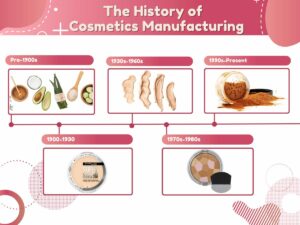
Pre-1900s
Cosmetics manufacturing began as early as Ancient Egypt, with an emphasis on natural ingredients and herbal remedies.
1900-1930
The industrial revolution led to the mass production of cosmetics for the first time, with the rise of large cosmetic companies like Maybelline, Max Factor and Coty.
1930s-1960s
Synthetic ingredients and water-based foundations and mascaras were first introduced in the 1930s, followed by the emergence of the ‘youth-oriented’ cosmetics industry in the 1950s, and the debut of the first aerosol sprays in the 1960s.
1970s-1980s
In the 1970s, waterproof cosmetics were developed, and the first hypoallergenic cosmetics were introduced. The 1980s saw the emergence of new makeup trends, such as the ‘smoky eye’ and the ‘no-makeup look.’
1990s-Present
The 1990s brought about a game-changing introduction in the world of cosmetics – mineral makeup, while the 2000s contouring and highlighting made their debut. Today, I’m excited to see cosmetics manufacturers focusing on more natural and organic products, as well as adopting sustainable and eco-friendly manufacturing practices.
I’ve always been fascinated by the industry’s rich history of innovation and evolution. From the earliest civilizations to modern times, cosmetics manufacturers have consistently pushed the boundaries to meet consumer demands.
2. Cosmetics Manufacturing Process: 5 Step Guide
Now that we have explored the fascinating history of cosmetic manufacturing companies, let’s take a look at the actual process of making these products. The cosmetics manufacturing process can be broken down into several steps, each of which plays a crucial role in creating the final product. Here’s a step-by-step guide to the cosmetics manufacturing process.
Step#1: Weighing and Mixing
In this step, the raw materials are weighed and mixed together to create a homogeneous mixture. This may involve heating or cooling the mixture to the desired temperature.
Step#2: Emulsification
Many cosmetic products, such as lotions and creams, require emulsification to create a stable mixture. Emulsification involves mixing two immiscible liquids, such as oil and water, to create a uniform emulsion.
Step #3: Filling
Once the product is fully mixed, it’s time to fill it into the appropriate packaging. This may involve using automated filling machines or manual filling depending on the type of product and the scale of production.
Step#4: Labeling and Packaging
After the product has been filled, it needs to be labeled with the appropriate branding, ingredient list, and regulatory information. The product is then packaged into its final form, such as a bottle or a jar.
Step#5: Quality Control and Testing
As someone who has worked in cosmetics manufacturing, I know firsthand the importance of quality control and testing. Ensuring that products meet safety and efficacy standards is crucial to building customer trust and loyalty. That’s why rigorous testing for microbiological contamination, stability, and other quality parameters is a must for any cosmetics manufacturer.
The cosmetics manufacturing process requires careful attention to detail and adherence to safety and regulatory requirements to ensure the safety and efficacy of the final product.
This video is all about the fascinating world of cosmetic manufacturing. We’ll take you through the step-by-step process of how cosmetics are made, from weighing and mixing the raw materials to filling, labeling, and packaging the final product.
3. Regulatory and Safety Requirements in Cosmetics Manufacturing
Now that we’ve seen how cosmetics are made, it’s important to know about the rules and safety standards that keep the industry in check. Cosmetics can be used on the skin, hair, and nails, so they have to be super safe and high quality to protect our health. So, what are the common regulations that cosmetics manufacturers have to follow?
FDA Regulations
The US Food and Drug Administration (FDA) regulates cosmetics under the Federal Food, Drug, and Cosmetic Act (FD&C Act). Under the FD&C Act, the FDA has the authority to regulate cosmetics and ensure that they are safe for use. The FDA regulates cosmetics based on their intended use, ingredients, labeling, and packaging.
Ingredient Safety
Cosmetics manufacturers must ensure that the ingredients used in their products are safe for use. They must perform safety assessments, including evaluating the toxicity, stability, and efficacy of the ingredients. In the US, the FDA maintains a list of ingredients that are not allowed in cosmetics due to their potential harmful effects.
Labeling and Packaging
Cosmetics manufacturers must ensure that their products are properly labeled and packaged. The label must include information such as the product name, ingredients, warnings, and instructions for use. The packaging must also be designed to protect the product from contamination and maintain its quality. I suggest, opting for airless pumps or tubes can help to keep the product fresh and increase its shelf life.
Good Manufacturing Practices (GMP)
Good Manufacturing Practices (GMP) are a set of guidelines that ensure that the cosmetics manufacturing process is safe and effective. GMP covers all aspects of manufacturing, including formulation, packaging, labeling, and quality control.
International Regulations
Cosmetics manufacturers must also adhere to international regulations. The European Union, for example, has strict regulations governing the safety of cosmetic products. The EU requires that all cosmetic products undergo safety assessments before they are sold in the market.
Complying with these regulations is vital to maintaining the integrity of the industry and protecting the health and wellbeing of consumers. This is necessary to ensure that the products produced by manufacturers like Nako Cosmetic are safe and effective for their customers.

4. Current Trends and Innovations in Cosmetics Manufacturing
The cosmetics manufacturing industry is constantly evolving, with new trends and innovations emerging all the time. This means that staying up to date with the latest technologies and developments is essential for companies in the cosmetics industry. Here are some key areas to focus on:
Natural and Organic Products
One of the biggest trends in cosmetics manufacturing today is the move towards natural and organic products. Consumers are increasingly conscious of what they put on their skin, and are looking for products that are free of harmful chemicals and made with natural and organic ingredients.
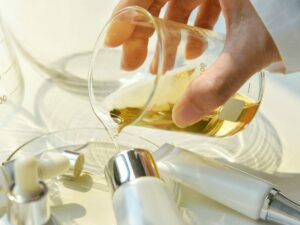
Sustainable and Eco-Friendly Manufacturing
Sustainable and eco-friendly manufacturing practices are becoming more important to both manufacturers and consumers. Companies are looking for ways to reduce their environmental impact, such as using recyclable packaging, reducing waste, and sourcing ingredients from sustainable sources.
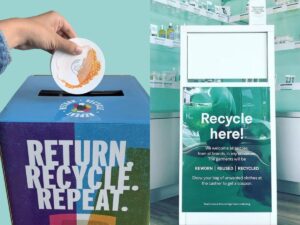
Innovative Packaging
Cosmetics packaging is becoming more innovative, with companies using new materials and designs to create unique and functional packaging. For example, some companies are using biodegradable materials, while others are using airless packaging to prevent contamination and maintain the quality of the product.

Inclusive Products
Inclusive products that cater to a diverse range of skin tones and types are becoming increasingly popular. Companies are creating products that are suitable for a wider range of consumers, including those with sensitive skin or unique needs.
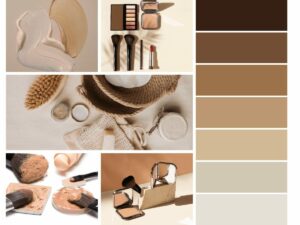
Advanced Technologies
Advancements in technology are also shaping the cosmetics manufacturing industry. For example, 3D printing technology is being used to create customized makeup products, while AI and machine learning are being used to develop more effective and personalized skincare products. I suggest, exploring these advanced technologies can help manufacturers stay ahead of the curve and offer innovative products to their customers.
Companies like Nako Cosmetic are adapting to these changes by embracing new trends and innovations, and working to create products that meet the changing needs and desires of consumers. As the industry continues to evolve, I’m confident that cosmetics manufacturers will continue to push boundaries, innovate, and create new and exciting products.
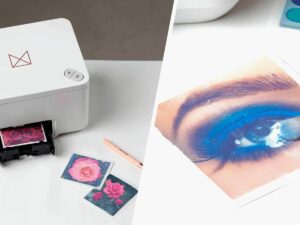
5. How To Start Your Own Cosmetic Line
Have you ever dreamed of starting your own cosmetics line? The cosmetics industry is highly competitive, but with the right knowledge and resources, it is possible to start your own successful cosmetics line. Here are some of the key steps to starting your own cosmetic line.
Step#1 Define Your Brand and Vision
Before you start your own cosmetic line, you need to define your brand and vision. What sets your products apart from the competition? Who is your target market? What are your brand values? These are all questions that you need to answer before you start creating your products.
Step#2 Conduct Market Research
Market research is essential to the success of your cosmetics line. You need to research the market to determine the demand for your products, identify your competitors, and determine the pricing for your products.
Step#3 Develop Your Products
Once you have defined your brand and conducted market research, it is time to start developing your products. This involves creating a formulation, designing the packaging, and testing the products for safety and effectiveness.
Step#4 Register Your Business and Products
Before you start selling your products, you need to register your business and products with the relevant regulatory authorities. This includes obtaining the necessary licenses and permits, and complying with all the regulatory requirements for the cosmetics industry.
Step#5 Build Your Brand and Market Your Products
Building your brand is essential to the success of your cosmetics line. You need to create a strong brand identity, develop a marketing strategy, and promote your products through various channels, such as social media, influencer marketing, and advertising.
To help you in this process, we have created a table outlining key components to consider when building your brand and marketing your products. The table includes details on brand identity development, marketing strategy, and promotional channels to consider.
Use this table as a reference to guide your brand and marketing efforts and ensure that your cosmetics line stands out in a competitive market.
| Aspect |
Description |
Considerations |
| Brand Identity |
Define your brand values, mission, and vision. Create a brand name, logo, and packaging design that aligns with your brand identity. |
Ensure that your brand identity is consistent across all platforms and materials. |
| Marketing Strategy |
Determine your target market and create a marketing plan that includes product positioning, pricing, promotion, and distribution. |
Conduct market research to determine the demand for your products and the pricing strategies of your competitors. |
| Social Media |
Use social media platforms, such as Instagram, Facebook, and YouTube, to promote your products, engage with customers, and build a loyal following. |
Develop a content strategy that showcases your products and engages with your target audience. |
| Influencer Marketing |
Collaborate with influencers and bloggers in the beauty industry to increase brand awareness and reach a wider audience. |
Choose influencers who align with your brand values and have a strong following in your target market. |
| Advertising |
Use traditional advertising channels, such as print and television ads, as well as digital advertising channels, such as Google Ads and social media ads, to reach potential customers. |
Develop a creative and impactful message that resonates with your target audience. |
| Public Relations |
Establish relationships with media outlets and industry influencers to generate buzz and coverage for your brand and products. |
Create a compelling brand story and pitch that sets your brand apart from competitors. |
| Packaging Design |
Create attractive and functional packaging that showcases your products and appeals to your target market. |
Consider the cost of materials and production when designing packaging. |
| Product Launch Events |
Host product launch events and other promotional events to generate excitement and interest in your brand and products. |
Determine the appropriate budget for events and consider the return on investment. |
| Pricing |
Determine the appropriate pricing strategy for your products. |
Consider factors such as production costs, competitor pricing, and perceived value of your products. |
Starting your own cosmetics line requires a lot of hard work, dedication, and attention to detail. However, with the right planning and resources, it is possible to create a successful and profitable cosmetics business.
6. 5 Factors To Consider When Choosing a Cosmetics Manufacturer
Choosing the right cosmetics manufacturer is a critical step in creating a successful and profitable cosmetics line. The manufacturer you choose will play a significant role in the quality, safety, and effectiveness of your products. In this section, we will explore some of the factors to consider when choosing a cosmetics manufacturer.
#1 Manufacturing Capabilities
One of the most important factors to consider is the manufacturing capabilities of the cosmetics manufacturer. You need to ensure that they have the right equipment, resources, and expertise to produce your products to the required standard.
#2 Quality Control
Quality control is another critical factor to consider when choosing a cosmetics manufacturer. You need to ensure that the manufacturer has strict quality control measures in place to ensure that your products are safe and effective for use.
#3 Regulatory Compliance
Regulatory compliance is essential in the cosmetics industry, and you need to ensure that the manufacturer you choose complies with all the necessary regulations and standards. This includes obtaining the required licenses and permits, and complying with all the relevant safety and quality standards.
#4 Experience and Reputation
Experience and reputation are also crucial factors to consider when choosing a cosmetics manufacturer. You need to ensure that the manufacturer has a proven track record of producing high-quality products, and that they have a good reputation in the industry.
#5 Cost and Flexibility
Cost and flexibility are also important considerations when choosing a cosmetics manufacturer. You need to ensure that the manufacturer can produce your products at a reasonable cost, and that they are flexible enough to meet your changing needs and demands.
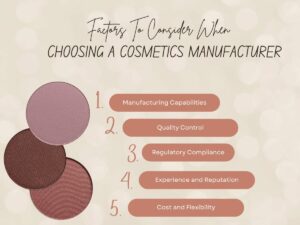
Dive Deeper Into Our Resources
For some insightful reads, we’ve curated a list of recommended articles just for you:
Still haven’t found what you’re looking for? Don’t hesitate to contact us. We’re available around the clock to assist you.
7. Conclusion
As someone who has been a part of the cosmetics industry, I can say that it’s an exciting and ever-changing field. It’s fascinating to see how manufacturers continue to evolve to meet consumer demands. Additionally, finding the right cosmetics manufacturer can make or break the success of your brand, so it’s a crucial decision to make.
At Nako Cosmetic, we are committed to producing high-quality, safe, and effective cosmetic products that meet the needs of our customers. Contact us today to learn more about our cosmetics manufacturing capabilities and how we can help you create your own successful cosmetics line.







